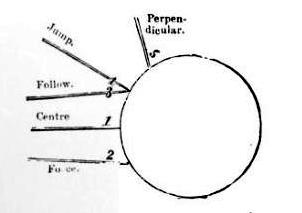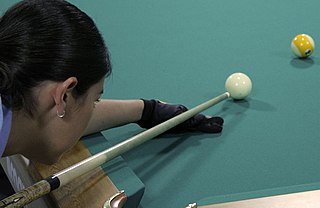
Cue sports are a wide variety of games of skill played with a cue, which is used to strike billiard balls and thereby cause them to move around a cloth-covered table bounded by elastic bumpers known as cushions.

Table tennis, also known as ping-pong and whiff-whaff, is a racket sport derived from tennis but distinguished by its playing surface being atop a stationary table, rather than the court on which players stand. Either individually or in teams of two, players take alternating turns returning a light, hollow ball over the table's net onto the opposing half of the court using small rackets until they fail to do so, which results in a point for the opponent. Play is fast, requiring quick reaction and constant attention, and is characterized by an emphasis on spin relative to other ball sports, which can heavily affect the ball's trajectory.

Kubb is a lawn game where the objective is to knock over wooden blocks by throwing wooden batons at them. Kubb can be described as a combination of bowling and horseshoes. Play takes place on a small rectangular playing field, known as a "pitch". "Kubbs" are placed at both ends of the pitch, and the "king", a larger wooden block, is placed in the middle of the pitch. Some rules vary from country to country and from region to region, but the ultimate objective of the game is to knock over the "kubbs" on the opposing side of the pitch, and then to knock over the "king", before the opponent does. Games can last from five minutes to well over an hour. The game can be played on a variety of surfaces such as grass, sand, concrete, snow, or even ice.

Skittles is a historical lawn game and target sport of European origin, from which the modern sport of nine-pin bowling is descended. In regions of the United Kingdom and Ireland the game remains as a popular indoor pub game.

Pool is a classification of cue sports played on a table with six pockets along the rails, into which balls are shot. Each specific pool game has its own name; some of the better-known include eight-ball, blackball, nine-ball, ten-ball, seven-ball, straight pool, one-pocket, and bank pool. Eight-ball is the most frequently played discipline of pool, and is often thought of as synonymous with "pool".

A pub game is one which is traditionally played inside or outside a pub. Most pub games date back many years and are rooted in village culture. Many derive from older outdoor sports.

Devil among the tailors is a form of table skittles which is usually found as a pub game in England. It is likely that the game emerged between 1675 and 1783 and surged in popularity during the 1920s and 1930s before waning again. Today it is found in scattered pockets across most of the country.
The following is a glossary of traditional English-language terms used in the three overarching cue sports disciplines: carom billiards referring to the various carom games played on a billiard table without pockets; pool, which denotes a host of games played on a table with six pockets; and snooker, played on a large pocket table, and which has a sport culture unto itself distinct from pool. There are also games such as English billiards that include aspects of multiple disciplines.

A basketball is a spherical ball used in basketball games. Basketballs usually range in size from very small promotional items that are only a few inches in diameter to extra large balls nearly 2 feet (60 cm) in diameter used in training exercises. For example, a youth basketball could be 27 inches (69 cm) in circumference, while a National Collegiate Athletic Association (NCAA) men's ball would be a maximum of 30 inches (76 cm) and an NCAA women's ball would be a maximum of 29 inches (74 cm). The standard for a basketball in the National Basketball Association (NBA) is 29.5 inches (75 cm) in circumference and for the Women's National Basketball Association (WNBA), a maximum circumference of 29 inches (74 cm). High school and junior leagues normally use NCAA, NBA or WNBA sized balls.

Cue sports techniques are a vital important aspect of game play in the various cue sports such as carom billiards, pool, snooker and other games. Such techniques are used on each shot in an attempt to achieve an immediate aim such as scoring or playing a safety, while at the same time exercising control over the positioning of the cue ball and often the object balls for the next shot or inning.

Five-pin billiards or simply five-pins or 5-pins, is today usually a carom billiards form of cue sport, though sometimes still played on a pocket table. In addition to the customary three balls of most carom games, it makes use of a set of five upright pins (skittles) arranged in a "+" pattern at the center of the table. The game is popular especially in Italy and Argentina, but also in some other parts of Latin America and Europe, with international, televised professional tournaments. It is sometimes referred to as Italian five-pins or Italian billiards, or as italiana. A variant of the game, goriziana or nine-pins, adds additional skittles to the formation. A related pocket game, with larger pins, is played in Scandinavia and is referred to in English as Danish pin billiards, with a Swedish variant that has some rules more similar to the Italian game.

Basque bowls, is one of the few Basque rural sports which do not originate in an activity related to rural or marine work. It has a number of other names too and is played in a bolatoki or bolaleku "bowls place" which often consists of a playing area in the open, an open sided structure with a low roof or a playing area located inside a colonnaded hallway.
Tokyo Friend Park 2 is a Japanese game show that premiered in April 1994 on the Tokyo Broadcasting Station (TBS). TFP2 airs on Monday nights roughly from 6:55 - 7:54 JST in Japan.

Ground billiards is a modern term for a family of medieval European lawn games, the original names of which are mostly unknown, played with a long-handled mallet, wooden balls, a hoop, and an upright skittle or pin. The game, which cue-sports historians have called "the original game of billiards", developed into a variety of modern outdoor and indoor games and sports such as croquet, pool, snooker, and carom billiards. Its relationship to games played on larger fields, such as hockey, golf, and bat-and-ball games, is more speculative. As a broader classification, the term is sometimes applied to games dating back to classical antiquity that are attested via difficult-to-interpret ancient artworks and rare surviving gaming artifacts.

Finnish skittles, also known as Karelian skittles, outdoor skittles or kyykkä, is a centuries-old game of Karelian origin. The aim in Finnish skittles is to throw wooden skittle bats at skittles, trying to remove them from the play square using as few throws as possible. Skittles can be played with four-man teams, in pairs or as an individual game. Finnish skittles is one of the three skittles games played in the World Championships of Gorodki Sport. The other games include Classic Gorodki and Euro Gorodki.

Danish billiards or keglebillard, sometimes called Danish five-pin billiards, is the traditional cue sport of Denmark, and the game remains predominantly played in that country. It makes use of a 5 × 10 ft six-pocket table, three billiard balls, and five pins, which are considerably larger than those used in the similar and internationally standardized game of five-pin billiards.
Pin billiards may refer to any of a fairly large number of billiard games that uses a pin, or a set of "pins" or "skittles". The earliest form of billiards, ground billiards, was played with a single pin called the "king". Table billiards kept the king until the mid-18th century. There are billiard games played with as many as thirteen pins.

A cue stick is an item of sporting equipment essential to the games of pool, snooker and carom billiards. It is used to strike a ball, usually the cue ball. Cues are tapered sticks, typically about 57–59 inches long and usually between 16 and 21 ounces (450–600 g), with professionals gravitating toward a 19-ounce (540 g) average. Cues for carom tend toward the shorter range, though cue length is primarily a factor of player height and arm length. Most cues are made of wood, but occasionally the wood is covered or bonded with other materials including graphite, carbon fiber or fiberglass. An obsolete term for a cue, used from the 16th to early 19th centuries, is billiard stick.





















